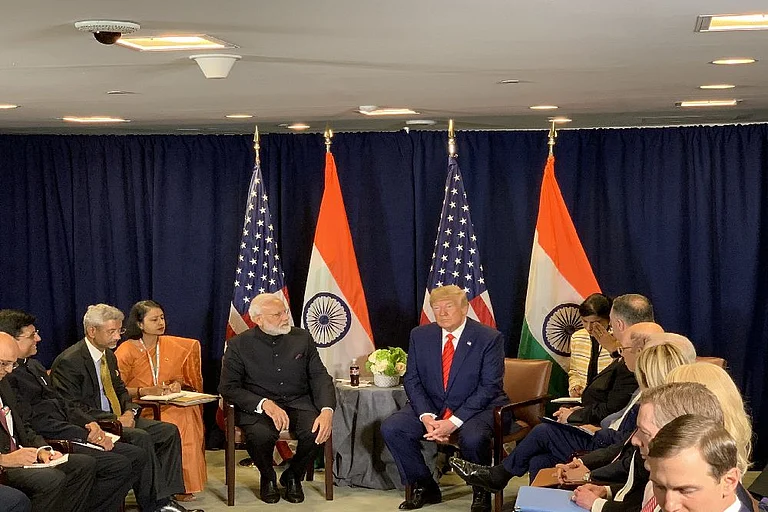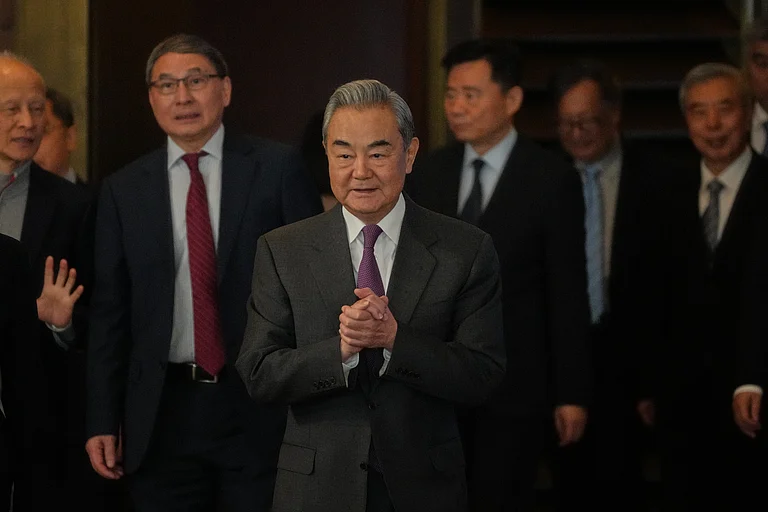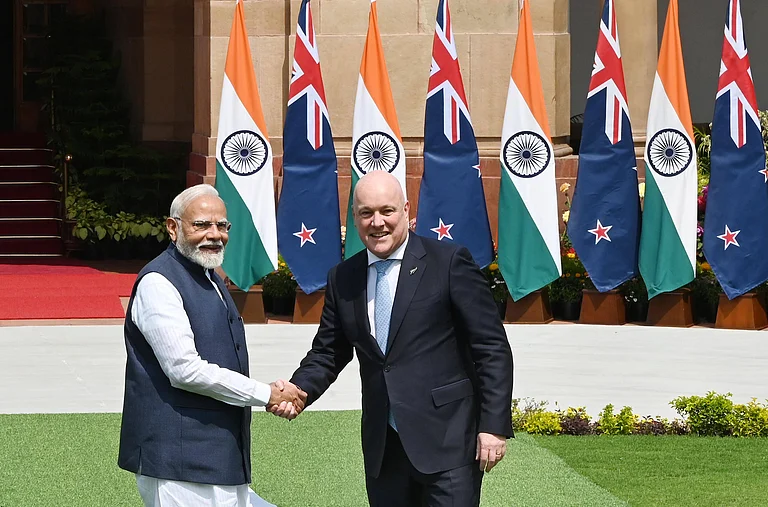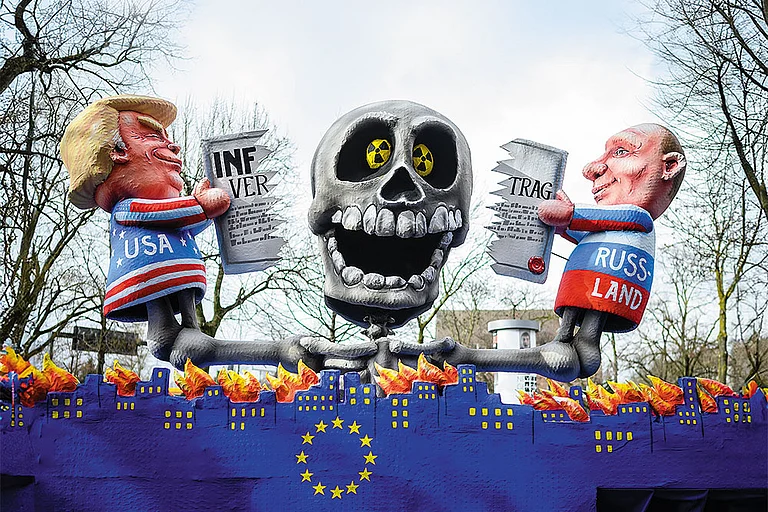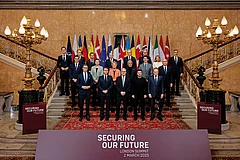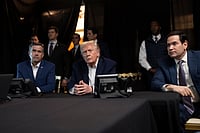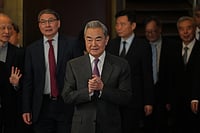When Donald Trump feted Prime Minister Narendra Modi as a “great leader” and was called a “friend” in return, the spotlight was back on what is often labelled a ‘bromance’ that dates back to his first stint as President of the United States. The personal chemistry, after all, was intact despite the deportation drive in which at least 388 Indians—going by Indian government figures—have been sent back to India, including some in chains, since Trump’s second inauguration. Then, on March 17, Trump shared a video link to Modi’s conversation with podcaster Lex Fridman in which the Indian PM says, “I stand for India First”, while Trump is for “America First”, and also recalls the 2019 Howdy Modi event in Houston where the US president “sat down below (in the audience), listening to me speak”, to praise his “remarkable gesture” of “humility”.
Earlier, on February 13, at a public appearance with Trump during his visit to the US, Modi said, “Borrowing an expression from the US, our vision for a developed India is to ‘Make India Great Again’, or MIGA. When America and India work together, when it’s MAGA plus MIGA, it becomes mega—a mega partnership for prosperity.” Later, in his interaction with Fridman, Modi said Trump seemed “far more prepared than before” and had a “clear roadmap in his mind, with well-defined steps”. Indeed, unlike during Trump’s first tenure, when New Delhi was nervous, not knowing what to expect, this time there is confidence that India has got his measure, and cautious optimism that any disruptions the mercurial president’s unanticipated moves cause can be handled.
While the world is more complicated today than it was during Trump’s first term, with Russia’s war on Ukraine and Israel’s war on Gaza having changed the security dynamic and competition among the global powers, the US president only seems to have become more brash. He now knows how to work the levers of power in Washington and winning the popular vote that had eluded him in 2016 has given him extra swagger. Moreover, he has Silicon Valley billionaires, including the world’s richest man Elon Musk, backing him.
Convinced that America had been taken for a ride by friends and foes alike, and bent on browbeating opponents to get a perfect deal, Trump has unleashed a trade war on the world and every country, including India, will have to bear the brunt. In fact, the sticking points in India-US ties under Trump 2.0 are not strategic or geopolitical, but concern tariffs and market access for US goods. As economics is linked to livelihoods, it can play into India’s domestic politics and potentially disrupt goodwill between the two countries.
Moreover, Trump’s insistence on reciprocal tariffs and US market access to India’s agriculture and pharmaceuticals sector would have repercussions for the Modi government. The Opposition has alleged that farmers’ interests have been sold out, referring to Trump’s off-the-cuff remarks last week that India wants to cut tariffs “way down now because somebody’s finally exposing them for what they have done”. “What has the Modi government agreed to? Are the interests of Indian farmers and manufacturing being compromised? The PM must take Parliament into confidence when it resumes on March 10,” Congress general secretary Jairam Ramesh posted on X.
The government has been ambivalent over Trump’s claims, with foreign secretary Vikram Misri telling the media that “we have in recent times entered into bilateral trade agreements based on tariff liberalisation with several partners” and there are “ongoing discussions with several other partners on these issues now”.
Handling pressure from the Trump administration on “opening up” Indian agriculture would indeed be a challenge. “Delhi will need to play a delicate balancing game as there will be turbulence, especially on the commercial front,” says Aparna Pande of the Washington-based Hudson Institute. “When most countries are bracing for the next round of tariffs or sanctions from Washington, New Delhi is relatively reassured. Modi has a good rapport with Trump, and India is key to USA’s Indo-Pacific strategy and the desire to counter China’s rise.” Perhaps this is why India is not publicly crossing swords with the US over tariffs. It hopes issues can be quietly dealt with behind closed doors during negotiations on the trade agreement announced during Modi’s meeting with Trump on February 13, which set an ambitious target of $500 billion for two-way trade to hit by 2030. India had already done some groundwork with finance minister Nirmala Sitaraman helping American businesses by slashing import duties on luxury cars, high-end motorcycles and other products in the budget.
Moreover, a bilateral trade deal talked of during Trump’s first tenure will be pursued more vigorously. “The two sides are committed to complete the first part of the trade pact by autumn, before Trump arrives in Delhi for the Quad (India, Australia, Japan and the US) summit,’’ says Observer Research Foundation’s Harsh Pant. “As trade talks are already on, the entire tariff table can be negotiated under the agreement. India is unlikely to retaliate with counter-tariffs as Canada, Mexico and China have done.”
Commerce minister Piyush Goyal was in Washington recently for talks. India’s trade surplus with the US was around $45 billion in 2024, but as a rule hovers around $35.20 billion. The US is pushing India to buy more oil and defence equipment, including helicopters, F-35 fighter jets and the Boeing P-8 Poseidon maritime patrol-cum-reconnaissance aircraft, to ease the trade imbalance. “Does India expect a good deal from Trump?’’ asks former Indian diplomat Ambassador K.P. Fabian. “Trump seems determined to carry on his trade war even though he runs the risk of a Waterloo in the November 2026 mid-term election. It is equally enigmatic that India is determined to have a $500 billion trade target with the US that wants to raise tariffs.”
Earlier in March, foreign minister Subrahmanyam Jaishankar said Trump is good for India at a talk in London’s Chatham House. “We see a president and an administration…moving towards multipolarity,” he explained. “That suits India.” Since 1945, the world has seen the US and the West as a bloc, but the needle is moving towards a “more national personality” as the Trump administration’s self-perception is more as a nation, Jaishankar added.
Trump’s emphasis on stable energy prices, too, helps India. “From Trump’s perspective, the one big shared enterprise we have is the Quad, which is an understanding where everybody pays their fair share… There are no free riders... So that’s a good model which works,” the minister said.
Strategic convergence on China’s growing economic and military clout in Asia and the world is the glue that has cemented India-US ties. The US regards China as its main rival ready to usurp its position as the world’s most powerful country. US secretary of state Marco Rubio had earlier said China was “the largest, most advanced adversary America has ever faced.” On its part, India has a territorial issue with China and needs to build alliances to thwart Beijing’s land grab on its eastern and western borders. Determined to become the paramount Asian power, China is spreading its influence in India’s backyard. Besides modernising its defence forces to counter Beijing, India is also tying up with the other major powers, with the US as kingpin, and the European Union, Japan, South Korea and Australia as the other partners.
Beyond China, India-US cooperation has now grown in every sphere, including emerging technologies that can leap-frog India’s growth in future—for instance, the US-India initiative on Critical and Emerging Technology (iCET). Converting India into a manufacturing hub, however, could clash with Trump’s bid to get companies to invest and manufacture in the US. Meanwhile, Trump blows hot and cold on China. Chinese President Xi Jinping was invited to his inauguration and a Trump-Xi rapprochement could change the equation between the US and India.
MORE FROM THIS ISSUE
Seema Guha is a senior journalist covering foreign affairs
This article is a part of Outlook's April 1, 2025 issue 'World At Reset', which explores the ongoing changes in the global geopolitical order. It appeared in print as 'Bromance'.









